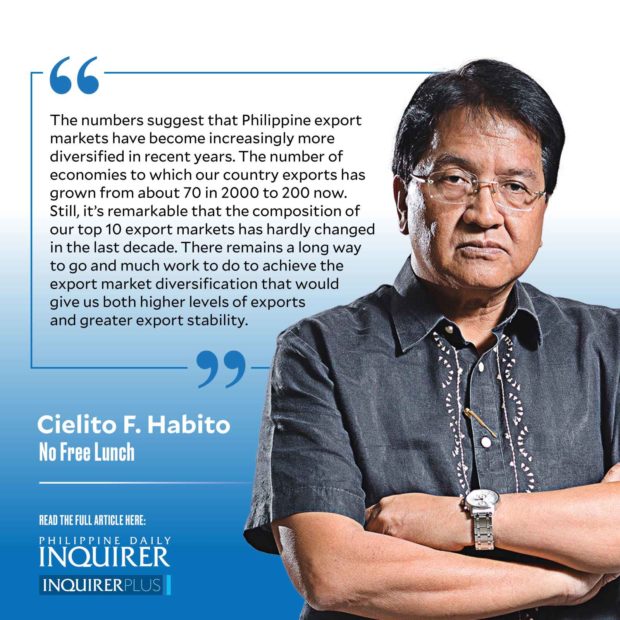Exporting more to more
 Among our comparable Asean neighbors, we export the least relative to the size of our economy, and it’s glaring. In 2021, Singapore’s exports amounted to an equivalent of 127 percent of its gross domestic product. The corresponding figure for Vietnam was 104, Malaysia 63, Thailand 54, and Indonesia 20 percent. Ours was a mere 14 percent.
Among our comparable Asean neighbors, we export the least relative to the size of our economy, and it’s glaring. In 2021, Singapore’s exports amounted to an equivalent of 127 percent of its gross domestic product. The corresponding figure for Vietnam was 104, Malaysia 63, Thailand 54, and Indonesia 20 percent. Ours was a mere 14 percent.
In times of global recession, such as is widely feared to be imminent now, this might be seen as a blessing in disguise, as we would have relatively much less to lose when export markets shrink in the face of declining incomes. But this doesn’t mean we should not be trying to sell overseas much more than we’ve managed to. After all, we need exports because they allow us to pay for goods and services that we import from abroad, especially those we can’t produce ourselves. And like it or not, we are a highly import-dependent economy, and I’m not referring to consumer goods like food and everyday products. The bulk—more than 80 percent—of our import bill goes to inputs to production, especially fuels, equipment and machinery, supplies and raw materials for our farms and factories (like fertilizers and chemicals), and intermediate products (like electronic chips that we assemble into semiconductors and circuit boards, which we in turn export). The lesson that Asian export-oriented countries learned from the last global slowdown in 2008-2009 was not that they should export less, but that they shouldn’t overly rely on dominant markets like the US and Europe as buyers of their exports. It’s important to “put our eggs in more baskets,” so to speak, so we don’t end up in big trouble if one or two of them drop. In short, export market diversification is crucial.
For many years, we have in fact put too much of our export “eggs” in too few baskets. For decades, the US, Japan, and Western Europe received the bulk of our exports. China and Asean changed that somewhat with their entry into the picture in the past decade or so, thanks to free trade agreements. This moderated the disproportionately high share that used to go to the US, especially. Asean, as a bloc, is now actually our biggest export market, with whom our total trade and exports now exceed that of China, Japan, or the US. Even so, we have continued to largely overlook fast-growing markets in such places as Central and Eastern Europe, and Latin America.
I’ve always felt we could do much better with the latter in particular. Back in the 1990s, I discovered in visits there that Mexico, Brazil, Argentina, and Chile were already trading briskly with neighbors like Malaysia and Indonesia, while our trade with them was a mere trickle. The irony about this is that our shared Hispanic colonial history with them should have been an advantage for us in fostering trade with these economies, as against our neighbors whose colonial ties were with the British and the Dutch. In fact, we were the gateway to the rest of Asia from the Americas and Europe in the era of the Manila-Acapulco galleon trade, spanning the 16th to 19th centuries. But Singapore and Taiwan have long taken that distinction away from us.
We have also been too dominantly reliant on electronics exports, mainly semiconductors and circuit boards (rather than finished products), which peaked at about two-thirds of all our merchandise export earnings, and still stand at around 60 percent. This has made our export sector unduly vulnerable to one industry’s ups and downs. And given that the world electronics industry has indeed been prone to such swings, the same instability is transmitted into the Philippine export sector and the economy at large.
Happily, things have been changing, albeit ever so slowly. The numbers suggest that Philippine export markets have become increasingly more diversified in recent years. The number of economies to which our country exports has grown from about 70 in 2000 to 200 now. Still, it’s remarkable that the composition of our top 10 export markets has hardly changed in the last decade. There remains a long way to go and much work to do to achieve the export market diversification that would give us both higher levels of exports and greater export stability.
cielito.habito@gmail.com
















